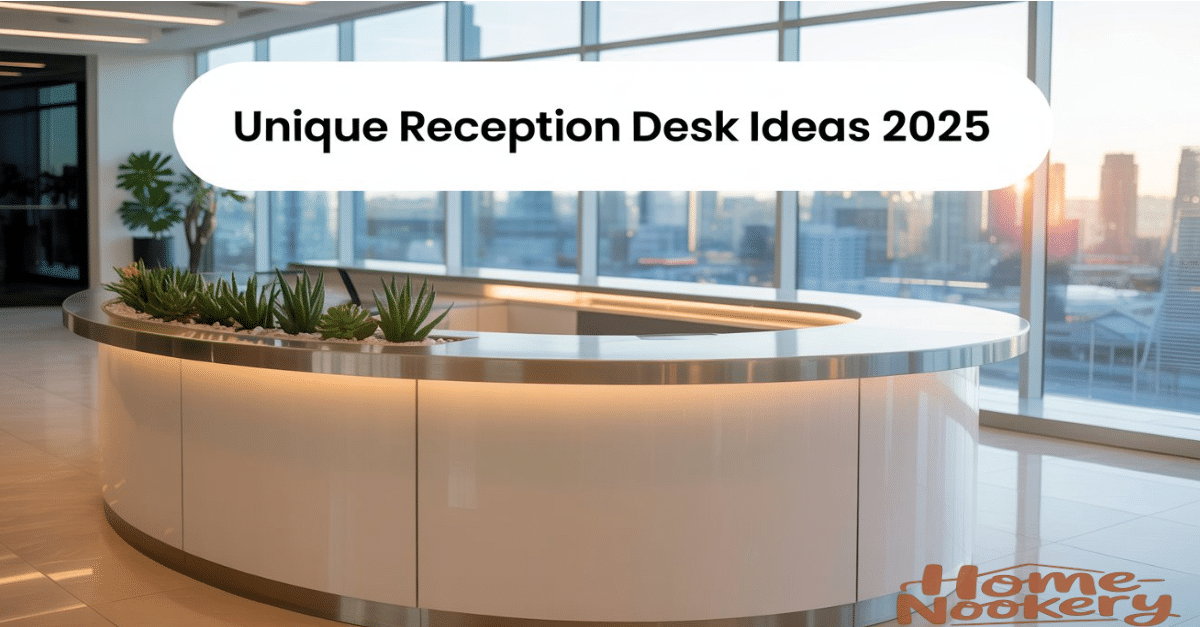First impressions matter more than we’d like to admit. When a client, customer, or visitor steps into your establishment, the reception desk is often the first physical touchpoint they encounter. It’s not just a functional piece of furniture—it’s a statement about your brand identity, values, and attention to detail. As we move through 2025, innovative reception desk designs are pushing boundries and redefining what these crucial spaces can be.
The humble reception desk has evolved from a simple utilitarian counter to a sophisticated brand ambassador. Today’s designs blend functionality with jaw-dropping aesthetics, cutting-edge technology, and sustainable materials. Whether your running a corporate office, a trendy salon, a high-energy gym, or a serene wellness center, your reception area sets the tone for the entire customer experience.
Let’s explore 15 truly unique reception desk ideas that are making waves this year. These aren’t your average cookie-cutter designs—each one offers something special that could transform your entrance area into an unforgettable experience.
1. Biophilic Living Walls
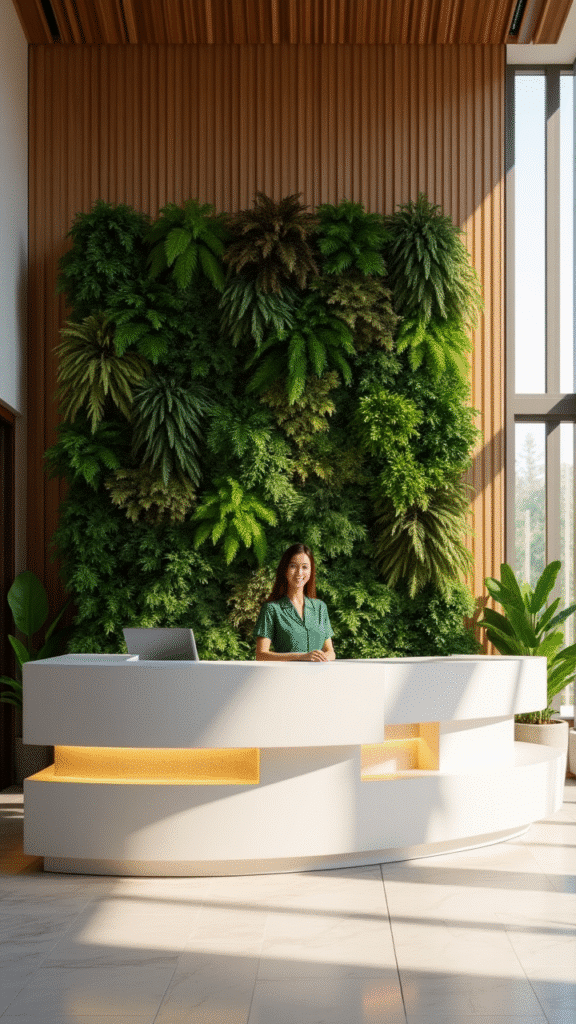
The biophilic revolution has officially reached reception areas, and it’s breathtaking. These desks incorporate actual living walls of plants, moss, and sometimes even small water features directly into the desk structure. The front panels can be partially transparent, allowing visitors to see the intricate root systems and soil layers.
What makes these desks exceptional is there ability to improve air quality while creating a powerful visual statement. Studies have shown that exposure to natural elements reduces stress and increases wellbeing, making these desks perfect for wellness centers, eco-conscious brands, and progressive corporate offices. Some advanced versions even incorporate automated watering systems and grow lights that activate after hours.
The maintenance is surprisingly manageable—most designs use low-maintenance plants and modular sections that can be easily replaced if needed. Expect to invest between $5,000-$12,000 depending on size and complexity, but the ROI in terms of impression and employee satisfaction is worth considering.
2. Kinetic Movement Desks
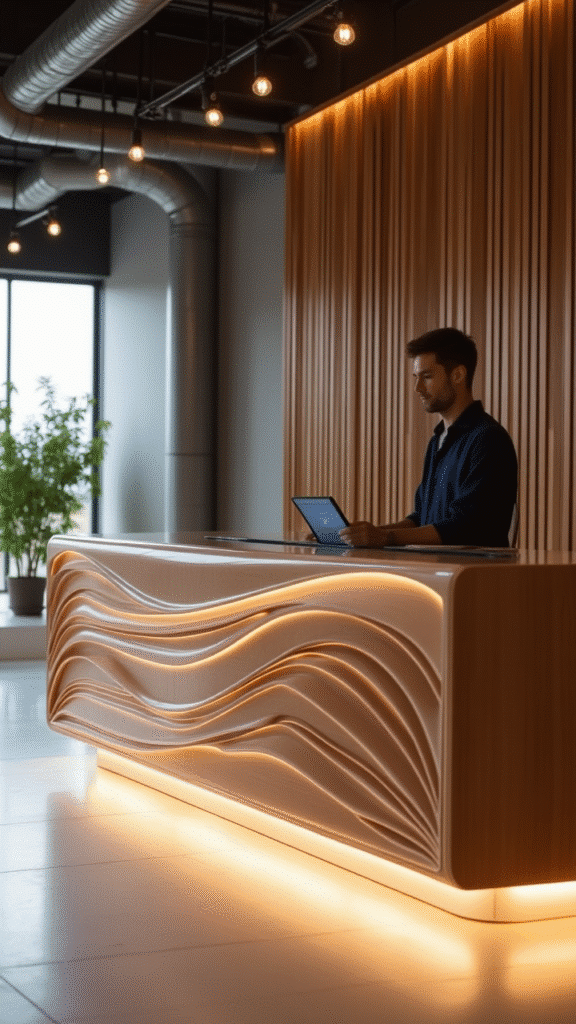
Forget static furniture. Kinetic reception desks incorporate subtle, flowing movements that captivate visitors the moment they walk in. Using silent motors and ingenious mechanical designs, these desks feature elements that slowly rotate, rise, fall, or transform throughout the day.
The effect is mesmerizing without being distracting. One popular variant uses a series of wooden slats that gently wave like ocean currents, while another features floating panels that adjust height based on whether the receptionist is sitting or standing. The technology behind these desks has improved dramatically, with battery backups ensuring the movements continue even during power outages.
These statement pieces work beautifully in creative agencies, architectural firms, and luxury hotels where innovation is part of the brand DNA. While premium models can reach $20,000, simplified versions start around $7,000 and still deliver that unforgettable “wow” factor.
3. Transparent LCD Embedded Counters
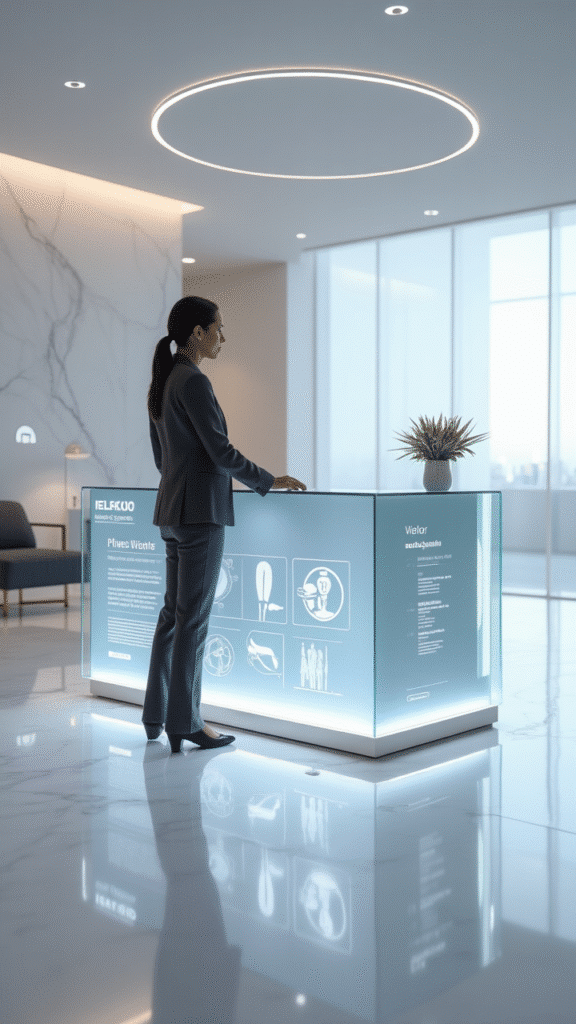
The line between digital and physical continues to blur with these cutting-edge desks. Transparent LCD panels embedded within the desk surface or front panels can shift from completely clear to displaying vibrant content in seconds. When inactive, they’re simply elegant glass elements of your desk.
What’s particularly clever about the 2025 iterations is there contextual awareness. Advanced models can detect when someone approaches and activate personalized welcome messages or relevant information. The glass surfaces double as touch interfaces, allowing receptionists to control content with simple gestures rather than relying on separate computers.
These tech-forward solutions are ideal for forward-thinking medical practices, tech companies, and high-end retail spaces. Installation costs typically range from $8,000-$15,000 depending on the number and size of screens, plus any custom programming requirements.
4. Sculptural Monoliths
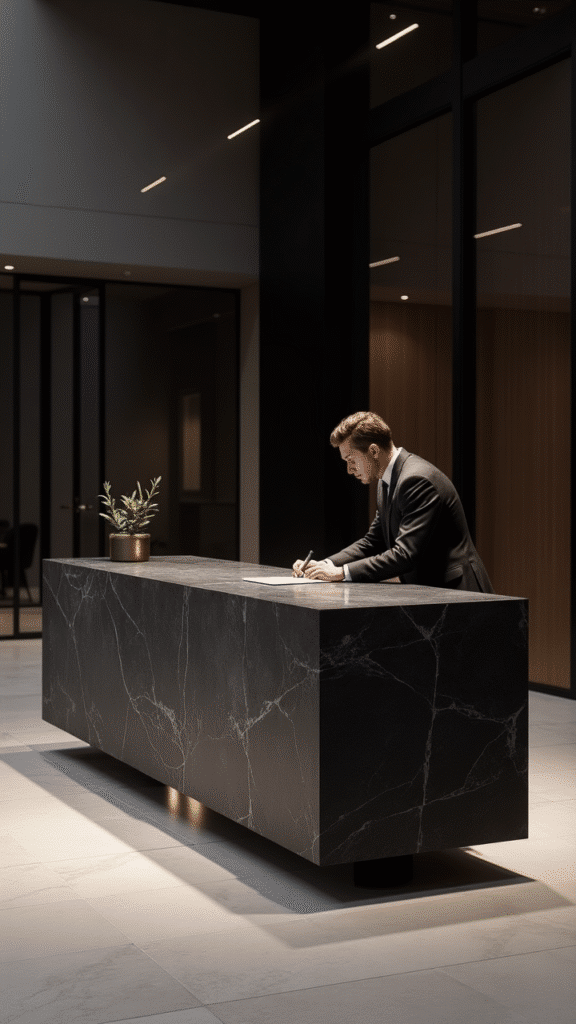
Minimalism reaches its magnificent peak with these bold, sculptural desks. Rather than traditional desk shapes, these designs embrace monolithic forms—single, dramatic pieces that appear to be carved from one massive material block. The visual impact is undeniable.
The beauty lies in their contradictions. They appear impossibly heavy yet somehow float above the floor. Their minimalist exteriors often conceal highly functional interiors with hidden storage, cable management, and ergonomic workstations. Materials range from polished concrete and natural stone to innovative composites that mimic luxury materials at a fraction of the weight.
These statement pieces excel in high-end law firms, art galleries, and boutique hotels where sophistication is paramount. While genuine stone versions can exceed $25,000, composite alternatives deliver similar visual impact starting around $9,000.
5. Illuminated Translucent Resin
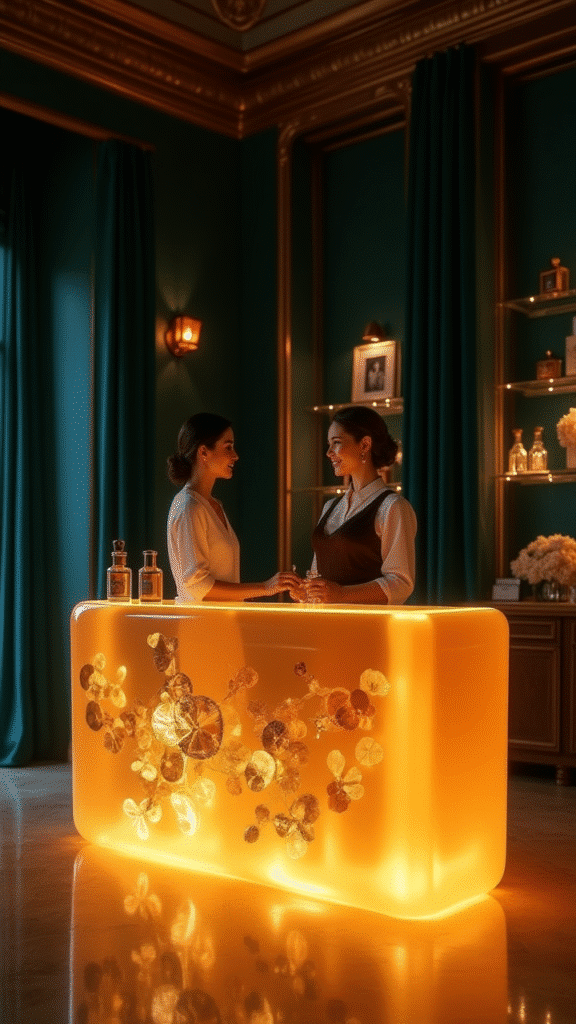
Light becomes a fundamental design element with these ethereal creations. Crafted from translucent resin with embedded LED systems, these desks literally glow from within. The most innovative designs for 2025 incorporate programmable lighting that can shift colors throughout the day or respond to external factors like weather or occupancy.
What’s truely fascinating is the customization potential. Some businesses embed brand-relevant objects within the resin—coffee beans for a café, fabric swatches for a fashion house, or circuit boards for a tech company. The items become suspended in the illuminated material, telling your brand story through physical objects.
These conversation-starting pieces are perfect for design studios, upscale restaurants, and boutique retail locations. Prices typically range from $6,000-$14,000 depending on size and complexity of the lighting systems.
6. Modular Reconfigurable Systems

Adaptability defines the next generation of reception desks. These ingenious systems consist of interlocking modules that can be easily rearranged to create different configurations based on changing needs. Need a larger surface for an event? A more intimate setup for one-on-one interactions? These desks transform in minutes.
The 2025 versions have eliminated the “temporary” look that plagued earlier modular furniture. Premium finishes, seamless connections, and integrated technology create a cohesive, permanent appearance despite their adaptability. Many systems include height-adjustable sections that cater to both standing and seated interactions.
This practical yet sophisticated approach works wonderfully for multi-purpose spaces, coworking environments, and businesses that frequently host events. Expect to invest $4,000-$10,000 for a comprehensive system with multiple configuration options.
7. Acoustic Sound-Sculpting Desks
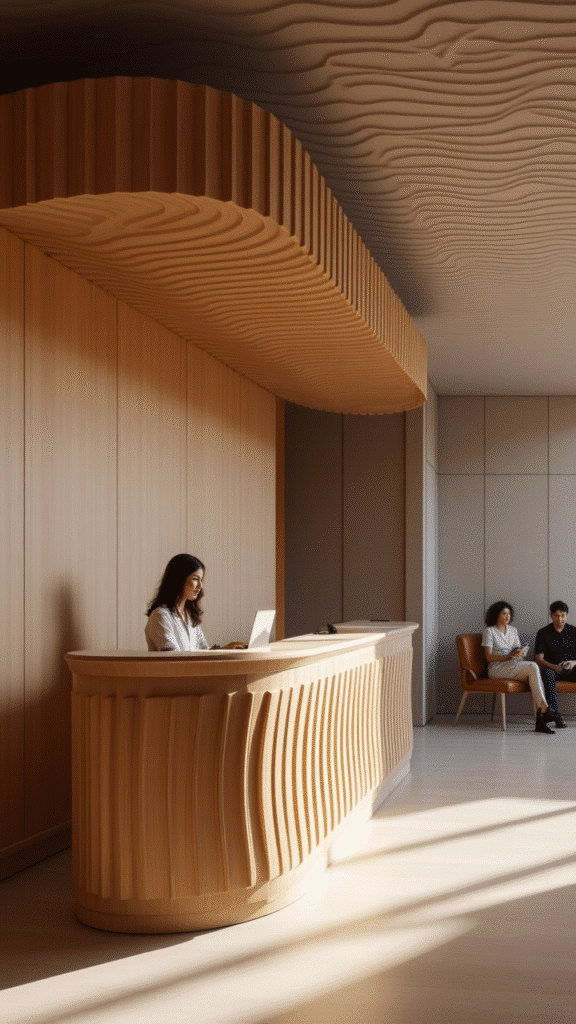
Privacy and sound management have become critical in open-plan environments. These innovative desks use advanced acoustic materials and shaped surfaces to direct and control sound in remarkable ways. Conversations at the desk remain private without the need for physical barriers.
The science behind them is fascinating—carefully calculated curves and specialized materials create “sound pockets” that prevent voices from carrying beyond the reception area. Some advanced models even incorporate subtle white noise generation that activates only when conversations are detected, providing an additional layer of acoustic privacy.
These practical solutions are ideal for medical offices, financial services, and any business where client privacy is paramount. Prices typically range from $5,000-$9,000, with the acoustic technology accounting for much of the cost.
8. Repurposed Industrial Heritage

Sustainability meets storytelling with these characterful desks crafted from repurposed industrial materials. Old machinery, factory flooring, architectural salvage, and decommissioned infrastructure find new life as stunning reception focal points. Each piece carries unique historical patina and character impossible to replicate.
The contrast between rugged industrial elements and modern office settings creates a compelling visual narrative. Smart designers balance the rawness of these materials with contemporary elements—glass surfaces for writing, modern lighting, and ergonomic workstations that satisfy practical needs while honoring the materials’ heritage.
These conversation-starting pieces work beautifully in creative agencies, breweries, urban restaurants, and brands with industrial connections. Costs vary widely based on the rarity of materials, running anywhere from $3,500 for simpler designs to $15,000 for pieces incorporating rare or significant historical elements.
9. Interactive Projection Mapping
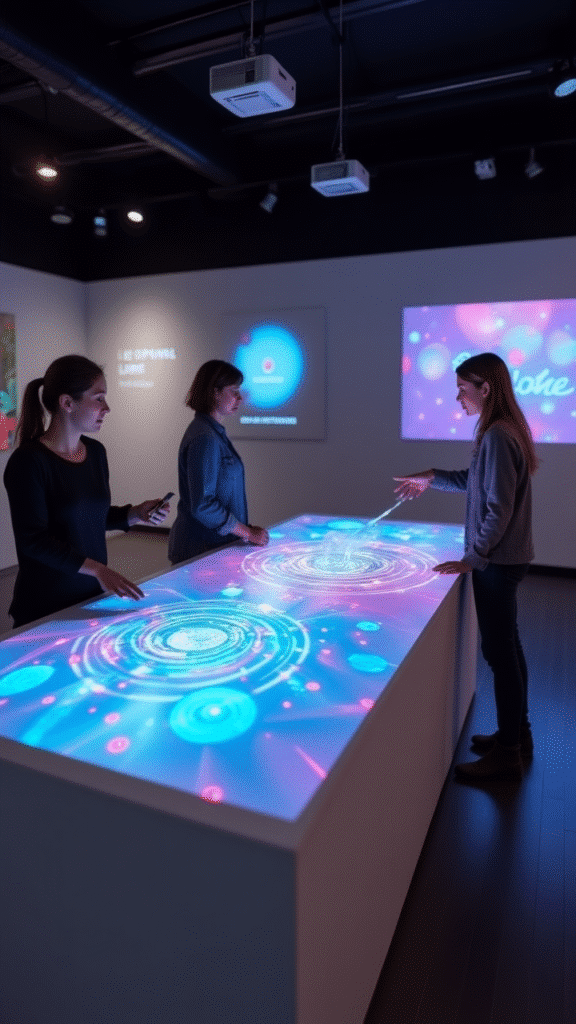
The physical desk becomes a dynamic canvas with these projection-mapping masterpieces. High-definition projectors transform ordinary surfaces into interactive displays that can change instantly. Unlike embedded screens, these systems can cover irregular surfaces and create illusions of depth, movement, and transformation.
The 2025 systems have overcome previous limitations of ambient light, now performing beautifully even in bright environments. Visitors can interact with the projected elements through motion sensors or touchpoints embedded in the desk. The content possibilities are endless—from immersive brand storytelling to practical wayfinding and information.
These attention-grabbing installations work particularly well for entertainment venues, museums, and innovative retail concepts. While the technology requires an investment of $7,000-$18,000 depending on complexity, the ability to update content digitally means the desk never becomes visually outdated.
10. Floating Cantilevered Designs
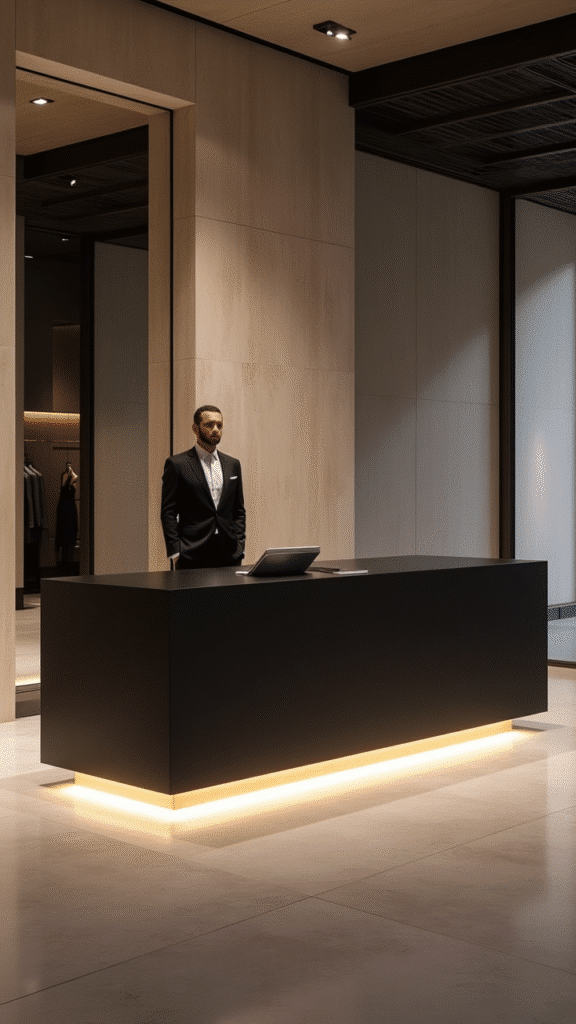
Defying gravity and expectations, these architectural marvels appear to float in space. Anchored to walls or floors at single points, these cantilevered desks project outward with no visible supports, creating a dramatic and seemingly impossible silhouette. The engineering behind them is sophisticated yet concealed.
What makes the 2025 versions particularly impressive is their structural strength despite the minimal visual footprint. Advanced materials and hidden structural elements allow these desks to support significant weight while maintaining their gravity-defying appearance. Some incorporate subtle lighting under the floating sections, enhancing the levitation effect.
These statement pieces are perfect for architectural firms, luxury property developments, and high-end fashion retailers where design sophistication is essential to brand identity. Expect investment levels of $8,000-$15,000 depending on size and materials.
11. Multi-Sensory Experience Desks
Reception becomes a full sensory experience with these boundary-pushing designs. Beyond visual impact, these desks incorporate elements that engage multiple senses—subtle fragrances, textural surfaces meant to be touched, and even carefully calibrated sounds. The most advanced incorporate gentle haptic feedback elements that respond to proximity.
The psychology behind them is fascinating—multi-sensory experiences create stronger memory imprints and emotional connections. Some luxury versions even incorporate temperature-controlled surfaces that offer comforting warmth in winter months or cooling touches during summer. The sensory elements can be adjusted throughout the day or seasonally.
These immersive creations are particularly effective for spas, luxury hotels, and high-end retail where emotional connection drives business success. While basic versions start around $6,000, fully-realized multi-sensory systems with comprehensive control capabilities can reach $20,000.
12. Adaptive Smart Materials
The vanguard of material science has reached reception areas with desks utilizing adaptive materials that change properties in response to environmental factors. Thermochromic surfaces change color with temperature fluctuations, while shape-memory alloys allow elements to transform when activated.
What’s specially impressive about the 2025 implementations is their reliability and subtlety. Earlier versions often felt gimmicky, but today’s adaptive materials change in sophisticated, purposeful ways. Some respond to the number of people in the space, gradually shifting to accommodate different energy levels throughout the day.
These science-forward designs excel in innovation centers, research facilities, and forward-thinking medical practices. While the cutting-edge materials command premium prices ($10,000-$18,000), they offer a unique opportunity to showcase innovation from the moment visitors enter.
13. Heritage Craft Revival
In counterpoint to digital minimalism, these desks celebrate traditional craftsmanship with extraordinary attention to detail. Hand carving, marquetry, metalwork, and other heritage techniques create pieces with soul and character. The 2025 approach isn’t purely traditional, however—these techniques are applied to contemporary forms, creating a fascinating dialogue between past and present.
The distinction between these and mass-produced options is immediately apparent. Visible tool marks, natural material variations, and the subtle imperfections of handwork create depth that machine-perfect surfaces cannot match. Many are created by master craftspeople using techniques passed down through generations.
These investment pieces make perfect sense for law firms, financial institutions, luxury brands, and any business where heritage and permanence are valued. Custom commissions typically range from $12,000-$30,000 depending on materials and techniques, but they’re intended as decades-long investments.
14. Convertible Space-Saving Solutions
Urban real estate premiums have inspired these ingenious space-optimizing designs. During low-traffic periods, these desks can transform—folding, sliding, or otherwise reconfiguring to free up valuable floor space for other purposes. The mechanisms are sophisticated yet intuitive, allowing quick transitions without specialized knowledge.
The brilliance is in the details—cable management systems that accommodate movement, locking mechanisms that ensure stability when deployed, and finishes that maintain their appearance despite frequent reconfiguration. Some models can even be fully concealed within wall panels when not needed.
These practical solutions make perfect sense for boutique retail, small medical practices, and urban professional services where every square foot matters. Prices range from $4,500 for simpler mechanical systems to $12,000 for motorized versions with advanced features.
15. Collaborative Hub Designs
The traditional barrier between “staff” and “visitor” dissolves with these community-focused designs. Rather than creating separation, these desks are configured to encourage collaboration, featuring accessible height, multiple approach points, and shared work surfaces. They function more as connection points than boundaries.
The 2025 versions skillfully balance this openness with practical needs—incorporating subtle security features, defined personal spaces for staff, and clever storage solutions that maintain organizational systems without creating visual barriers. Many include configurable elements that can adapt to different interaction modes throughout the day.
These welcoming setups are transforming coworking spaces, community organizations, and progressive educational institutions. They typically range from $3,500-$8,000 depending on size and material quality, generally costing less than traditional barrier-style desks.
Making Your Selection
Choosing the right reception desk goes beyond aesthetics—it’s about aligning your physical space with your brand values, operational needs, and the experience you want to create. Consider how visitors will interact with the space, the practical requirements of your reception staff, and the technological infrastructure needed to support your operations.
Budget certainly plays a role, but view your reception desk as a long-term investment in your brand experience rather than simply a furniture purchase. The right desk will continue delivering returns through positive impressions and operational efficiency for many years.
Remember that customization is always an option—many manufacturers can adapt their designs to incorporate your specific requirements, branding elements, or space constraints. The extra investment in customization often pays dividends in functionality and brand alignment.
Your reception area creates that crucial first impression that shapes every subsequent interaction. In 2025, the options for making that impression memorable, on-brand, and functionally superior are more diverse and exciting than ever before. Choose wisely, and your reception desk will serve as both a practical workspace and a powerful brand ambassador for years to come.

Mariana is the founder and voice behind Home Nookery, a curated blog dedicated to home design, décor inspiration, and cozy living. With a passion for creating beautiful, functional spaces, Mariana shares practical tips, styling ideas, and thoughtful insights to help readers turn their houses into homes. Whether you’re redesigning a room or just adding a touch of charm, she’s here to guide you with creativity and heart.
